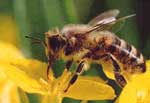When most of us hear of undocumented border crossings between Mexico and the western United States, we immediately think of devastating social problems: refugees fleeing poverty and political oppression, or drug runners laundering money and offering controlled substances to our children.

I think that I shall never see, a poem lovely as a bee.
And yet, there is another kind of traffic crossing the U.S.-Mexico border that is wholly beneficial to inhabitants on both sides of the geopolitical line. As you read this, migratory pollinators are crossing the international boundary, visiting wildflowers as they travel up their nectar corridor from tropical Mexico to the Intermountain West.
These pilgrims are largely undocumented, under-appreciated, and therefore at risk. Lesser long-nosed bats normally pollinate century plants, but are threatened by the inappropriate gating of mines or by the dynamiting of cave roosts where tens of thousands of pregnant females aggregate each spring. The white-winged dove populations that pollinate saguaro cactus in Arizona have dropped 50 percent within our lifetimes, as their riparian tree roosts have died off or come under the plow. Rufous hummingbirds have suffered a 5 percent decline in population for several years running, perhaps due to vegetation change reducing “fuel availability” at their stopovers from Jalisco to Alaska. And monarch butterflies now face more herbicides killing their host plants in the Great Plains than ever before.
Should these pollen-carrying pilgrims continue to decline, the colors, fragrances, and productivity of American wildlands may be diminished as well. Pollination, one of nature’s services that we’ve always assumed to be free and therefore unworthy of our investment and care, may soon cost American consumers several billion dollars a year in increased food prices. Why? There are now fewer domestic honeybees left in North America than at any other moment during our lifetimes, and they are not likely to recover in number before we die. If we continue to fragment wildland habitats where wild pollinators dwell, farmers will be forced to invest in husbanding other semi-managed pollinators, and will pass on their costs to you and me.
One hundred of the top biologists in Mexico and the U.S. recently convened in Tucson, Ariz., to figure out how to protect our valuable migrant pollinators. They concluded that we must protect the many flowering plants along nectar corridors, as well as the major roosts where pollinators stop over and winter. Pesticide use on both sides of the border must be more carefully managed and more diligently monitored, as must the spread of exotic species of plants that take over native habitat.
Pollinators are exposed to many risks because they do not occur in an ecological vacuum. Neither do humans. Ironically, some pollinators follow much the same routes up the west coast of Mexico into the southwestern U.S. that Spanish-speaking migrant farmworkers do while picking the winter vegetables upon which most of us depend. These farmworkers are exposed to many of the same insecticides and herbicides that birds, bats, and butterflies may succumb to because of their smaller body sizes. In effect, migratory wildlife may be the early-warning indicators that something is awry in the relation between regional environmental health and human health. Many migrant farmworkers’ lives are being tragically impaired by toxins whose effects often show up first in wildlife.
The next time you hear or read of perilous border crossings, think of what other lives may be at risk if these undocumented pollinators ever stop coming across. Our wholehearted support for conservation efforts by Mexican ecologists is needed just as much as such support is needed here “at home.” These pollinators need to be safe in both countries.

